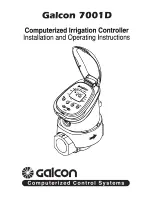
Operating Instructions, Form No. 102808, Back sheet 2 of 3
Pressure Switch
A pressure switch can be adjusted to stop the pump motor at a desired pressure setting and restart the motor when
the pressure falls below that setting.
It is recommended that a pressure switch be used with a pressure regulating valve to insure accuracy when setting a
maximum PSI level. A pressure switch alone will break the motor’s energy supply at a selected setting, but the
hydraulic pump will continue building pressure as it slows to a stop. The pressure regulating valve is adjusted at a
setting slightly above the pressure switch setting to compensate by releasing the pressure developed by the hydraulic
pump as it “coasts” to a stop. As a result, the pressure limit requirement can be held to approximately 300 PSI.
Adjusting The Pressure Switch Setting
1. Loosen the locknut on the pressure switch. Slowly turn the pressure switch adjusting screw in a counterclockwise
(CCW) direction, decreasing the pressure switch setting until the pump motor shuts off. Tighten the locknut to lock
the adjusting screw.
2. Release the hydraulic pressure. Run the pump to check the pressure setting and automatic shutoff of the motor. It
may be necessary to make a second fine adjustment.
PREVENTIVE MAINTENANCE
WARNING:
To help avoid possible personal injury,
•
Disconnect the pump from the power supply before performing maintenance or repair procedures.
•
Repairs and maintenance should be performed in a dust-free area by a qualified technician.
Bleeding Air from the System
Air can accumulate in the hydraulic system. This air causes the cylinder to respond in an unstable or slow manner. To
remove the air:
1. Position hydraulic cylinder(s) on their sides with the couplers located upward and at a lower level than the pump.
2. Remove any load from the cylinder(s), and cycle the hydraulic system through several cycles (fully extend and
retract the cylinders).
3. The bladder must be vented and refilled (see "Filling the Bladder" section on sheet 2 of 3).
Hydraulic Fluid Level
1. Check the oil level in the bladder after each 10 hours of use. With all cylinders retracted and the pump in the
upright (or vertical) position, the oil level should be at the top of the filler hole.
2. When adding oil, use Power Team approved, high-grade hydraulic oil (215 SSU @ 100
°
F). Retract the cylinders
and disconnect the power supply. Clean the area around the filler plug, remove the plug, and insert a clean funnel
with filter.
3. The frequency of oil changes will depend upon the general working conditions, severity of use, and overall
cleanliness and care given the pump. Three hundred hours of use under general shop conditions is considered a
standard change interval. Drain, flush, and refill the bladder with Power Team approved, high-grade hydraulic oil
(215 SSU @ 100
°
F).
Maintenance and Cleaning
1. Keep the pump's outer surface as free from dirt as possible.
2. Seal all unused couplers with thread protectors.
3. Keep all hose connections free of dirt and grime.
4. Equipment connected to the pump must be kept clean.
5. Use only Power Team approved, high-grade hydraulic oil in this pump.
Change as recommended (approx. every 300 hours).









































